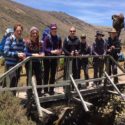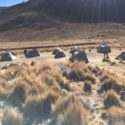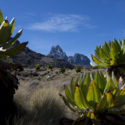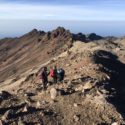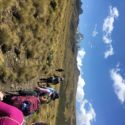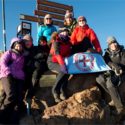The original concept for the trip to climb Mount Kenya was sown mid-way round our Mini Tour of Mont Blanc in the summer of 2015, for which the Ulysses Trust kindly provided a grant. The FANY links with Kenya started in 1931 with the establishment of a Section of 16 members, which had risen to 600 strong by 1941. This particular link to Corps heritage, combined with the fact that members of the Corps have always been great travellers, made an expedition to the summit of Mount Kenya an exciting and challenging prospect. Eighteen months in the planning, with regular day and weekend walking trips, retail excursions and last minute panics, this was going to be a real adventure for the eight FANYs who had signed up for the expedition. For some, it was their first taste of Africa and, for all bar one, the first time any member had undertaken such a challenge at altitude.
After an initial night in Nairobi, we travelled to Bantu Mountain Lodge on the lower slopes of Mt Kenya, a convenient overnight stop before the start of our high-altitude trek. We met our guides, Sammy and Peter, who would aid us on our journey. As part of our acclimatisation we embarked on an afternoon nature trail and caught our first glimpses of Kenya’s wonderful display of animals, flora and fauna.
Having enjoyed our last night in an actual bed for several days we were all eager to set off for Sirimon Gate and the start of our expedition. We departed just after lunch and headed towards Old Moses Hut, our first night’s lodge. The path took us through forest surroundings where we saw a plethora of wildlife including birds and monkeys. We reached Old Moses Hut in the late afternoon and, after a quick snack of tea and biscuits, we headed further up the mountain for an acclimatisation walk before our much welcomed dinner.
The next day, we had a beautiful walk from Old Moses Hut, ascending gently through the most stunning landscape and vegetation to Likki North Camp. Not only did we have our first introduction to Lobelias, but we met the most extraordinary of all, the Ostrich Plumed Lobelia, discovered by the explorer Samuel Teleki and only found on the slopes of Mount Kenya. We encountered many Mountain Chat birds along the way, Red Capped Warblers and a Black-Shouldered Kite to name a few, and the day was crowned with a sighting of two Eland antelopes grazing in the evening light on the opposite hillside.
After a night in tents with the lowest temperature recorded as -6.8 degrees centigrade, we set off at 0830 hrs. We had undertaken a mini acclimatization walk the day before so we knew what to expect to get past the first ridge. However, it would be fair to say that this was a particularly challenging day, with our destination often appearing closer than it actually was, due to the number of hidden summits we had to scale. We walked amongst magnificent scenery as we passed a fast flowing stream still with icicles in it despite the blazing sun. Finally Shipton’s Caves loomed into view, straight ahead of us, leading us towards our home for the night. We were all fatigued by the heat, but focused on reaching Shipton’s Camp. Sammy and Peter, last thing before dinner, showed us the route we would be taking the next day for the ascent to the summit with the instructions to “be strong, have courage and be flexible”. Words that would turn out to be very prescient.
It was with trepidation and excitement (and many layers of clothing) that we left Shipton’s Camp at 3am. With head torches on and poles at the ready we trailed each other nose to tail like elephants. The path had a gradual steep incline and the unstable scree doubled the effort. We moved slowly and steadily like a conveyor belt. We found out early on not to look to the side and thus shine our head torches down a steep ravine plummeting away beside us.
It took four hours in freezing temperatures to reach the summit. However, constant support and encouraging words to each other maintained our mental strength and morale. A shooting star seen half way there also acted as a good omen. We summited just as the sun was rising, the blood red clouds, the colour of Africa, visible on the horizon. Finally we climbed the vertical shelf and stepped on to the rocky platform that was Lenana, 4985m high.
We congratulated each other and took brief photos before the wind and extreme cold could be tolerated no longer. We began the tricky descent, clambering over rocks whilst holding on to the guide rope, then traversing more steep scree slopes. It was at this point that the guides again came into their own, providing strong arms and soothing words. At one point three of us, with one of our guides leading, formed a chain holding on to outstretched poles to support each other, much like when you learn to ski. This got us down the steepest parts when thighs and knees were starting to tire.
The views of Batian behind us and a huge glacier were spectacular, and after three hours we reached Mackinder’s Camp. We gratefully ate a hot breakfast under a tired haze, the significance of what we had achieved not having sunk in due to exhaustion. We rested for a couple of hours and departed at noon, for our stop for the night. We finally reached the Met Station for a well-earned rest, having climbed the equivalent of Ben Nevis at altitude, walked for over 12 hours and covered approximately 23km.
Our week in Kenya presented the team with a significant physical challenge and an opportunity to step out of our comfort zones. Following many months of training and preparation for this difficult climb, we all returned to England with a great sense of pride and accomplishment. We were overwhelmed not only by the hospitality of the people we encountered but also by the African landscapes of Mount Kenya and the incredible wildlife of the Aberdare National Park. It was an amazing achievement, but one which would have been far more difficult and far less enjoyable had it not been for the outstanding support and care shown to each other by each FANY, and for the assistance from our wonderful guides. The Mount Kenya expedition certainly proved that ‘This FANY Can’!
Our very grateful thanks go to the Ulysses Trust for their support towards the financing of the FANY Mount Kenya Expedition, which was hugely appreciated by all team members.

